When and How to Harvest Cannabis for Maximum Trichome Retention
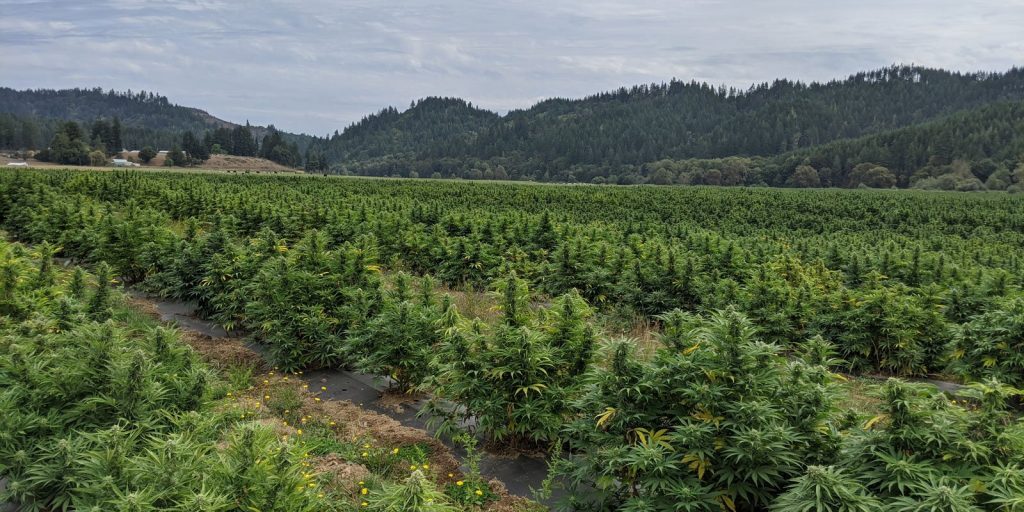
For optimal trichome retention and a highly potent product, you need to know when and how to harvest cannabis. The appearance of trichomes and pistils helps you determine when to harvest. Additionally, the selection and combination of your trimming methods will determine how well you retain trichomes during and after the harvesting process.
Trichomes are the resin glands of the cannabis bud that store cannabinoids like CBD, making their preservation vital for the most potent and highest-quality harvested cannabis flowers. Harvesting cannabis at the right time ensures you achieve maximum potency and crop weight. It can be easy for cultivators to harvest too soon or too late, thus depriving their final product of its full potential and value. Even a few days can make a difference in the potency of the final product.
Here we’ll offer a complete guide for preserving trichomes on cannabis buds, including why they’re so important, whether wet or dry trimming works better for trichome preservation, and the best time to harvest cannabis plants to ensure optimal trichome retention.
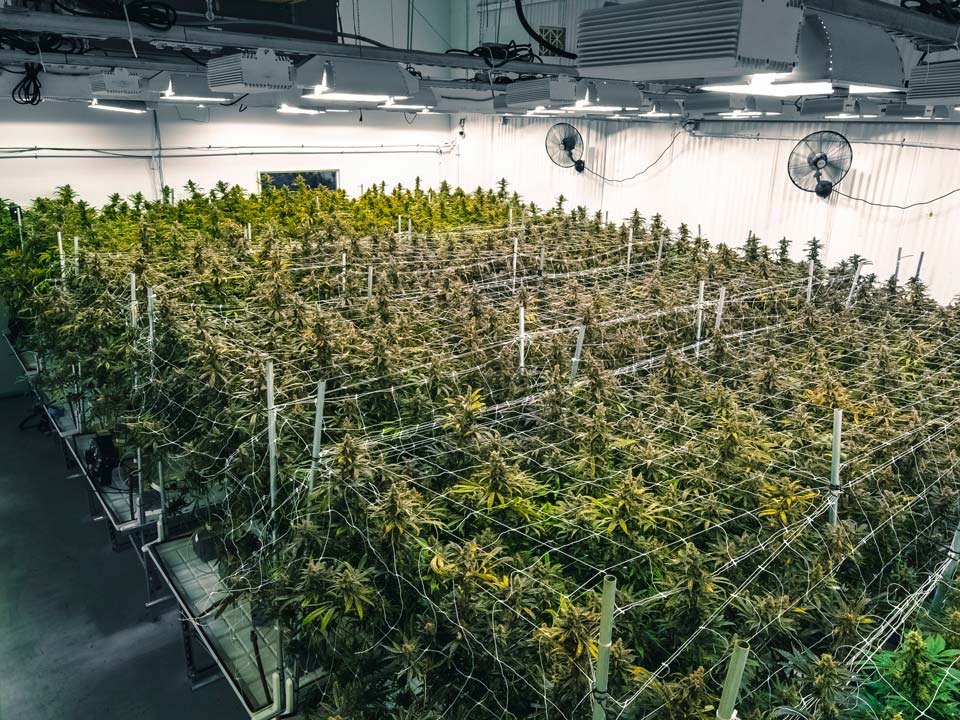
Why Preserving Trichomes On Cannabis Is So Important
If you look closely, you’ll notice cannabis flowers are covered in small crystals. These crystals are known as trichomes, and they begin to develop when a female cannabis plant enters the flowering stage of growth.
The word “trichome” stems from the Greek word trikhōma, which translates to “growth of hair”. Trichomes appear as sticky resinous hairs that cover the buds and small leaves of cannabis flowers.
Trichomes are largely considered one of the most important parts of the cannabis plant, as cannabinoids, terpenes, and flavonoids are formed in these resinous glands.
A cannabis flower contains three different types of glandular trichomes, including:
Bulbous Trichomes
- Bulbous trichomes are the smallest of the three cannabis trichomes. They’re so small (approximately 20 micrometers) that they’re only visible with a microscope. They are typically found on stems and leaves, with only a small portion appearing on cannabis flowers.
- Bulbous trichomes are the first of the three trichomes to turn amber, which is typically a sign that cannabis flowers are ready to harvest.
- Bulbous trichomes don’t contain cannabinoids, although some suggest they may contribute to the formation of CBGA (the acidic precursor to CBG from which all other cannabinoids stem).
Capitate-Sessile Trichomes
- Capitate-sessile trichomes are the most abundant of the three trichomes on the cannabis plant. They’re medium-sized (approximately 75 micrometers) with a long stem that contains a round tip, and they are barely visible to the naked eye.
- Capitate-sessile trichomes contain a moderate amount of cannabinoids and are found on cannabis leaves and flowers.
Capitate-Stalked Trichomes
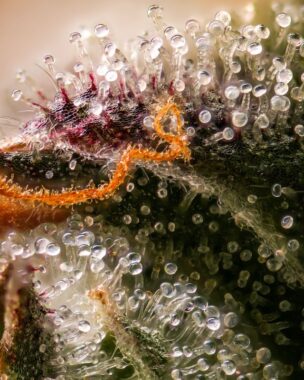
- Capitate-stalked trichomes are considered the most valuable glandular trichomes, as they produce the majority of cannabinoids and terpenes. They are structurally similar to capitate-sessile trichomes, only much larger (approximately 500 micrometers).
- Easily visible to the naked eye, these trichomes appear as a long stalk with a round bulbous head—very much like mushrooms. They form in abundance during the flowering stage and cover buds, bud sites, and sugar leaves.
- Capitate-stalked trichomes are the most susceptible to damage, and care should be taken to protect these fragile trichomes during cultivation and throughout the harvesting process.
The main reason trichomes are considered so important is because they contain cannabinoids, terpenes, and other compounds, all of which affect the quality and potency of harvested cannabis flowers. They also serve a significant role in protecting cannabis plants from predators.
Trichome production begins when the marijuana plant reaches the flowering stage of its life cycle. When cannabis flowers begin to mature, the plant becomes increasingly susceptible to various predators. Trichomes act as a defense mechanism, as the bitter flavor and strong aroma of the resin glands serve to deter animals and insects.
Why Experts Often Disagree About When To Harvest Cannabis
Experienced growers offer conflicting advice on timing their cannabis harvesting. There are many reasons for the differences in opinion, including personal preference. Cannabis harvested earlier will have a more uplifting, cerebral effect. Cannabis harvested later will be more calming.
Further, some of the confusion comes from the plant itself. Strains—more accurately called cultivars—express their ripeness differently. The indicators for when to harvest can take a different amount of time for each to reach that ideal harvest window.
Moreover, connoisseurs value individual cultivars for their unique chemical profiles. Some strains lend themselves to a more cerebral effect, meaning they would benefit from an earlier harvest. Other strains may fare better with a later harvest.
Some cultivars, such as Early Girl, can be ready for harvest after just 49 days of flowering, while others take more than 100 days to mature (like Hazes and Jack Herer). Your genetics supplier can give you an estimate for the cultivar’s crop cycle, though your growing and environmental factors will play a role as well.
In terms of chronology, some Sativa cultivars prefer a seemingly endless “summer” and a 16-week flowering period. At the opposite extreme, Indicas may flower in as little as 5 weeks.
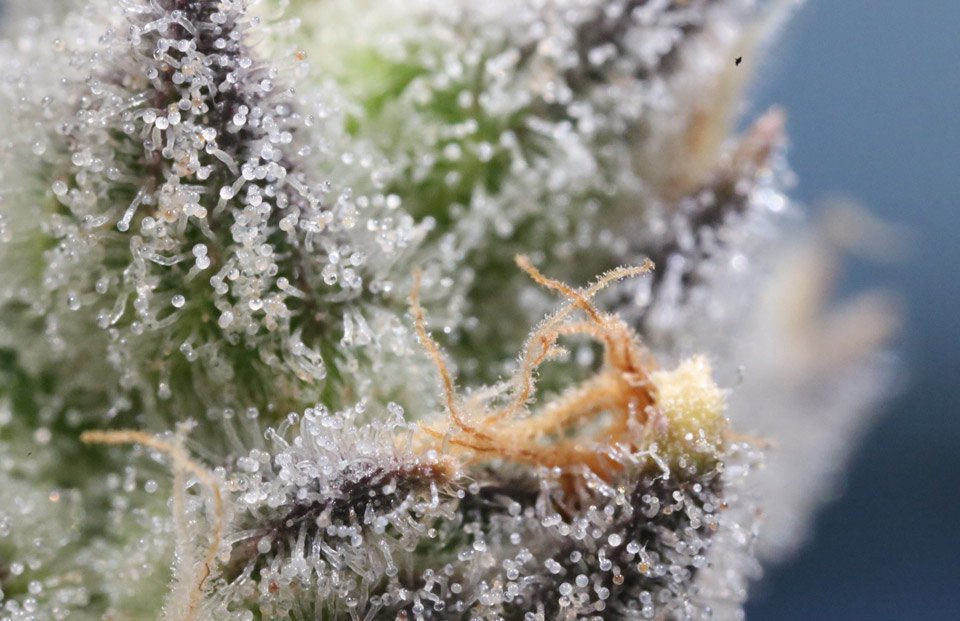
What’s more, cannabis flowers mature unevenly across an individual plant. The top flowers receive more light than the bottom flowers. Because the lower flowers get less light, they are often less potent and have fewer cannabinoid-rich trichomes.
Some growers may choose to delay harvest day — and risk possible cannabinoid degradation — to maximize harvest weight. It’s true that plants continue to build biomass in the final days of flowering, but does this strategy work? It’s hard to say, and the results may be heavily cultivar-dependent.
The terpene profile of cannabis changes as the flowers mature and peaks a little later than certain cannabinoids. Growers who want more or different terpenes may delay their cannabis harvest, particularly if they’re immediately freezing the crop for fresh-frozen extraction or other applications.
All these factors can make knowing when to harvest cannabis confusing, and they can affect your harvest planning and standard operating procedures, too. If you pay close attention to your growing cannabis plants and observe the indicators, you will dramatically increase your chances for a successful harvest.
The Goal In Timing Your Harvest
To ensure maximum potency and trichome retention, cannabis growers must harvest marijuana when trichome development has reached a specific point, and the flower contains the correct amount of each desired cannabinoid.
Because female cannabis plants spend their final days focused on resin production, cultivators must take them down during the brief window of their peak ripeness—before the medicinal compounds start to degrade.
Harvesting Cannabis Plants Too Early
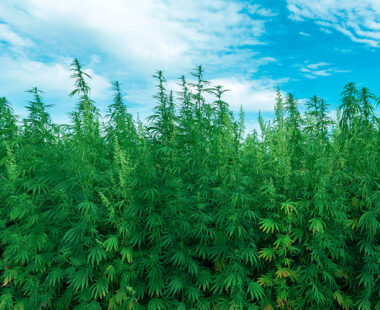
Harvest cannabis plants too early, and buds will contain low levels of certain cannabinoids, reducing the value of your crop. Trichomes will not have time to mature to their chemical peak when harvested too early. You’ll be left with a harvest high in cannabigerolic acid (CBGA). CBGA is the precursor cannabinoid to most other cannabinoids, including CBD. It is abundant during vegetative growth and slowly converts to other types of cannabinoids throughout the flowering phase. As a result, peak trichome retention comes when the CBG levels are near zero.
If your cannabis crop tests high in CBGA, you probably harvested too early. The plants didn’t have time to metabolize the CBGA into other compounds. Some cultivators may use in-house chemical testing to determine when CBG levels have dropped, indicating peak potency levels.
While it’s true that CBGA has great potential as a medicine and there’s a stronger market for CBG-rich hemp, cannabis connoisseurs are focused on other cannabinoids, including CBD and terpenes, not the precursor cannabinoids found in the plant.
Harvesting Cannabis Plants Too Late
Throughout the reproductive phase of your crop cycle, cannabinoids increase — up to a point. After that point – the optimal harvest date – certain cannabinoids begin to decompose. The cannabinoid that you’ve worked so hard to cultivate converts to less desirable compounds.
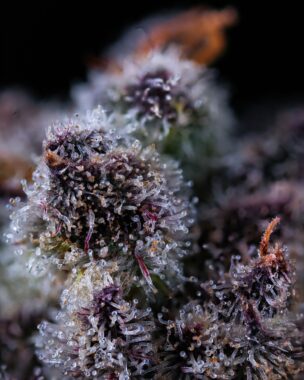
Oxidation, heat, and ultraviolet light convert the compound into its “degradation cannabinoid,” cannabinolic acid (CBNA). CBNA becomes CBN when it decarboxylates by losing a carbon atom. CBN has proven medicinal properties but little market value. The same happens with cannabis flowers in storage: potency slowly degrades into CBN. While CBN has some sedative/anti-anxiety effects, most users prefer higher potency and CBD concentrations.
Pathogens can also creep up on an overdue crop. A mature cannabis bud has a massive surface area and deep crannies that can breed botrytis. If humidity is too high and botrytis sets in, your potency levels won’t matter — the crop will need remediation or disposal.
In summary, the goal in harvesting for peak trichome retention is to time that small window where both CBG and CBN are very low. Too early, CBG will be too high. Too late, and CBN will be too high.
Determining When To Harvest Cannabis For Maximum Trichomes
Trichomes and pistils are two of the most accurate visual indicators for determining when cannabis is ready to harvest. They provide insight into that perfect harvest window for your cannabis crop. You can also refer to the leaf color as an indicator as well.
When fan leaves turn yellow late into the flowering stage, it’s not a sign of nutritional deficiencies. It just means that the resources that were supporting photosynthesis have turned completely toward reproductive growth. The plant knows the season is ending, and it’s trying to produce seeds.
When the fan leaves turn yellow and fall, harvest day is very near. If you’re using fertilizer, however, you may not observe yellowing leaves at harvest time.
Along with these indicators, cannabis cultivators can use chemical lab testing if they have access to equipment.
The Trichome And Pistil Method
Knowing when to harvest weed for the best trichome retention all comes down to trichome and pistil color. Consumers often refer to pistils as “hairs”—and with good reason. The slender, white pistils point outward from the flower’s calyx, attempting to receive pollen and produce seeds.
You’ll want to closely examine the trichomes and pistils to determine if the growing cannabis plants are ready to harvest. A 30-100X handheld microscope is the best choice for scoping out the trichomes on your plants, but a jeweler’s loupe or a cell phone magnifier works well enough. A DSLR camera with a macro lens is another great way to assess your trichomes while also documenting your harvests.
Examining Trichomes
Keeping in mind that capitate-stalked trichomes contain the highest levels of some cannabinoids, these are what you’ll want to look for when determining harvest time for optimal trichome retention. Look for trichomes that resemble tiny mushrooms with a bulbous head, as this is where most of the cannabinoids and other beneficial compounds are contained.
Once capitate-stalked trichomes have been identified with a magnifier, you’ll want to look at their color. If trichomes are clear, they still need time to mature, as they’ll contain very low levels of some cannabinoids.
The ideal trichome coloration is a matter of personal preference. Some growers prefer to harvest when 25% of the trichomes are amber, and the rest are milky or clear; others like to let the plant go a little longer and shoot for 50% amber/ 50% milky. A general guideline to follow is to harvest cannabis only if more than half of your trichomes have turned a cloudy, milky color.
Generally, if there are a lot of amber trichomes on the plant, you can expect a sedative “body high” experience. If the trichomes are mostly cloudy, the effects are more cerebral.
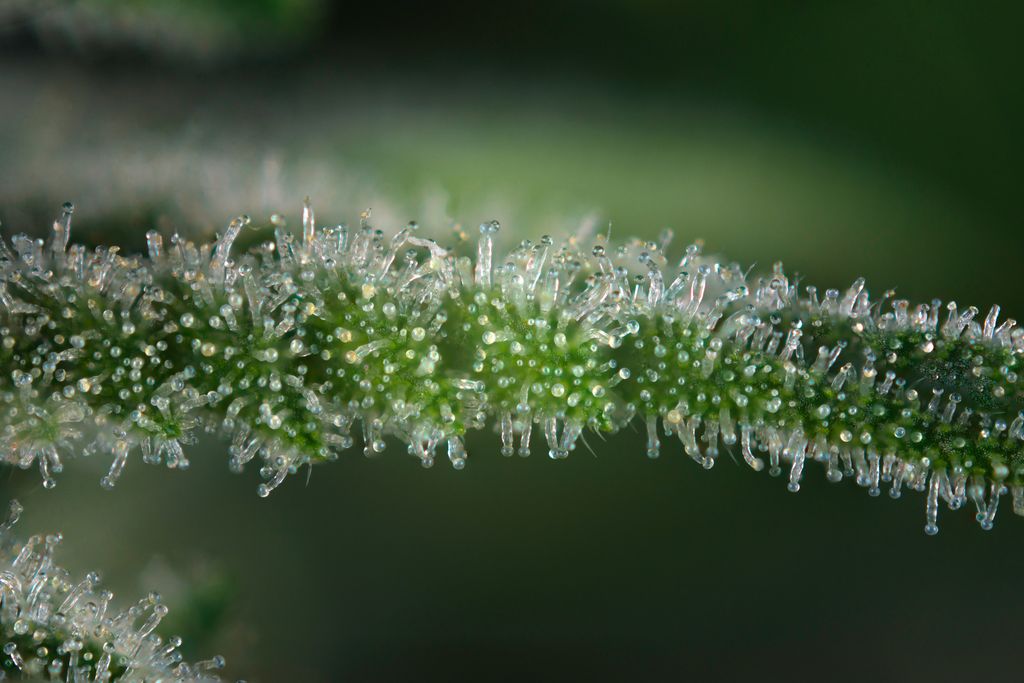
Examining Stigmas And Pistils
After evaluating trichomes, the stigmas and pistils are another good indicator of when it’s time to harvest. Stigmas are the portion of the pistils that stick out from the bracts of the flower. Most stigmas turn a reddish brown when they’ve matured, but you may also see orange, red, purple, pink, or even blue. Regardless of the color, when 75% of the stigmas have changed in color, that’s a good way to time your harvest as well.
The pistils look like “tiny hairs” and are typically white while they are still maturing. Allow the marijuana plant to continue in the flowering stage until at least 50-70% of these “hairs” turn an amber hue, and trichomes have gone from clear to predominantly cloudy. When harvested at this stage, consumers tend to experience the strongest high and medicinal effects.
Keep in mind that if you wait too long and trichomes turn amber, you will lose potency. The key thing to look for is milky, cloudy trichomes, as they contain the highest potency levels.
Checking For Potency With Laboratory Testing
Cultivators with access to chemical and laboratory testing equipment have more control. By tracking their crop’s cannabinoid concentrations, they can pinpoint when potency levels are at their peak based on a few factors.
Final cannabinoid concentrations are unpredictable, so when chemical testing, cultivators use a different strategy: they track CBG. The general guideline here is to time your cannabis harvest when CBG levels drop close to zero.
Small cannabis testing units cost a few thousand dollars, but for commercial growers, they can pay off almost immediately. A potency bump from 17% to 19% yields a notable increase in market value. This type of data-driven decision-making will soon become the industry standard.
Real-World Harvest Schedules
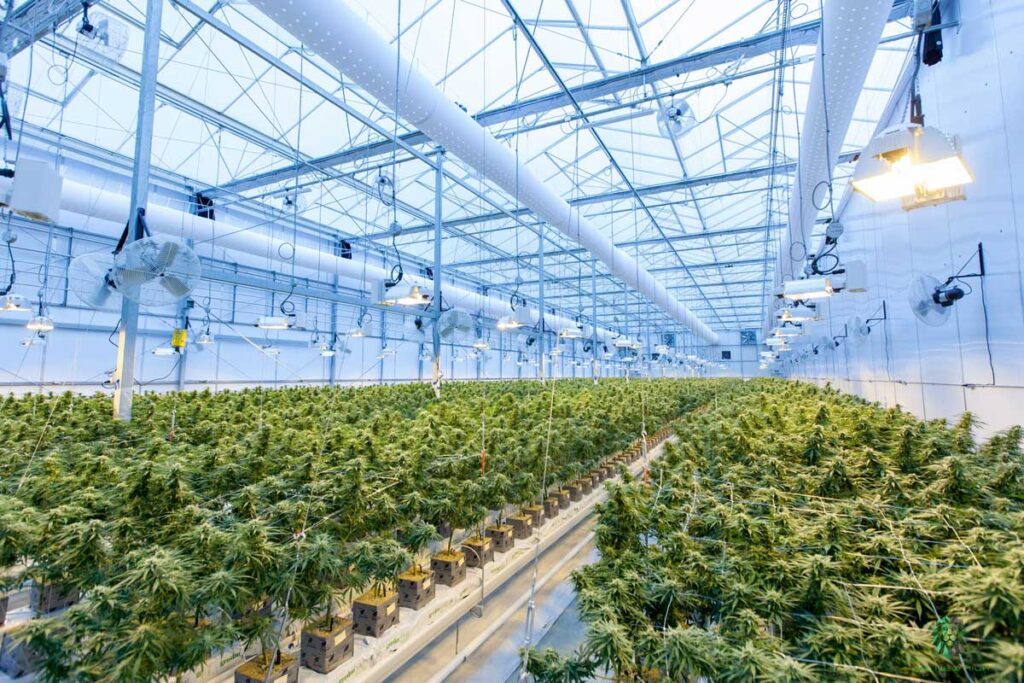
In reality, most growers use both trichomes and pistils as indicators of when to harvest. Experience and instinct play a role too, as does the cultivator’s preference for a cerebral, uplifting effect (from an early harvest) or an anti-anxiety, bodily effect (from a delayed harvest). Staff availability is another critical consideration.
The season dictates biology for outdoor plants. If you are an outdoor cannabis grower, year-to-year weather variations may impact schedules. But in general, Northern California growers typically harvest in late October or early November. Washington State and Colorado growers harvest sooner — usually in mid-October — due to wet weather and cold temperatures, respectively.
Outdoor cannabis plants can take a light freeze for two or three hours, but prolonged low temperatures or exposure to temperatures lower than 28℉ cause cellular ice crystals to form and trichomes to rupture. Getting the plants down before a big storm is better than waiting for perfectly milky trichomes—and risking crop loss to cold or wet weather. Sometimes a suboptimal harvest is better than nothing at all.
Mold and pests may also necessitate early harvesting, to minimize the risk and exposure of your plant to these organisms. Geography plays a role too — so climate, wildfires, drought, and more can influence when you harvest your crops. As a result, making generalized recommendations about outdoor harvest dates is difficult.
The stress of pests, bad weather, or nutrient lockout could also cause a cannabis plant to flower later. Depending on these conditions, the cultivar may be ready to harvest sooner or later than you were expecting based on just its genetics. With this in mind, it’s important to keep a close eye on all aspects of growth.
After Cannabis Harvesting: Trimming That Preserves Trichomes
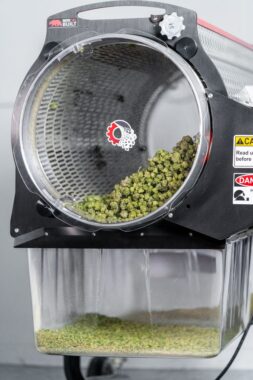
Once cannabis is harvested at its peak potency, efforts still must be made to preserve that potency. Growers have two options when it comes to processing their harvest: machine trimming and hand trimming. The method chosen will ultimately have an impact on the trichome retention of the flower as well.
Machine trimming allows for perfectly manicured buds that can be trimmed quickly. While machine trimmers of the past would over-trim buds and destroy valuable trichomes, advances in technology have led to machine trimmers that preserve cannabis trichomes.
Hand trimming has been used for years. While much slower than machine trimming, skilled trimmers with meticulous attention to detail can preserve cannabis trichomes.
Which is better for preserving precious trichomes on the cannabis buds? Here, we’ll take a look at the pros and cons of each to gain a better understanding of which method might be best for you.
Hand Trimming
Pros:
- Low up-front cost
- Appealing to the eye
- Ability to highlight an individual strain’s unique features
Cons:
- Time-consuming
- High labor costs
- Requires hiring and managing trimmers
- Only beneficial for small operations, as commercial growers typically have large amounts of product that must be processed
Machine Trimming
Pros:
- Perfectly trimmed buds appealing to the eye
- Increased ease and efficiency of trimming large quantities of cannabis
- Advances in technology allow for increased trichome retention
- Good for small, medium, and large grow operations, eliminating the need to hire and manage trimmers
Cons:
- Low-quality machine trimmers can reduce the appearance of buds
- Some machine trimmers can be noisy to run
- The initial cost for high-quality machine trimmers can be expensive (investment is returned over time, however, with saved labor costs)
Wet Trimming Vs. Dry Trimming: Which Is Better For Preserving Trichomes On Cannabis?
Wet trimming or dry trimming is something else growers must decide on when harvesting cannabis.
Wet trimming involves trimming when cannabis flowers are freshly cut from the plant before they have dried. Dry trimming involves drying cannabis flowers prior to trimming.

Talk with one grower, and you’ll be convinced of the merits of wet trimming. But talk with another, and you’ll start questioning the first grower’s judgment and become a staunch proponent of dry trimming.
The reality is that the best method depends on the grower’s strengths, harvesting conditions, trimming equipment, and the end product. The debate is alive and well. Here are some advantages and disadvantages of each:
Wet Trimming
Advantages:
- Less material handling
- Trichomes are less brittle when buds are wet, which can reduce breakage and increase retention
- Less susceptible to mold or fungus during the drying process
Disadvantages:
- Must be trimmed immediately after harvest, or it becomes more difficult to trim
- Requires more equipment cleanup than dry trimming
Dry Trimming
Advantages:
- The trimming process doesn’t need to be done immediately
- Clean-up of equipment is quicker and easier
Disadvantages:
- Requires more space as plant material must be hung to dry
- Flowers are more susceptible to damage when trimmed dry, which can result in loss of trichomes
- Must remove fan leaves prior to trimming, which increases the labor time
Additional Harvesting Tips For Max Trichome Retention
Harvest In The Morning Or Before Lights Come On
Cannabis spends the nocturnal period producing resin and the photoperiod (i.e., daytime) driving photosynthesis. The metabolites involved in photosynthesis may cause a suboptimal taste.
Consider A Staggered Harvest
Because the top portions of the plant mature more quickly, you may choose to harvest those parts first and give the bottom flowers another week to build potency and trichome density.
Have A Complete Harvest Plan
For large grow ops, harvest preparation starts months in advance—long before any trichomes turn milky. Preparation includes staff training, equipment purchases, and detailed standard operating procedures (SOPs) for what will happen on harvest day.
Harvesting For Fresh Frozen
If you intend to process your plants using fresh-frozen extraction techniques, harvest several days earlier than you would otherwise.
Set Up Your Processing Room
Harvest day can be very busy. It’s best to have your processing space ready to go for when the harvest is ready. Consider the flow of cannabis material when setting up your workflow. This includes the placement of your buckers, trimmers, and any extraction equipment.
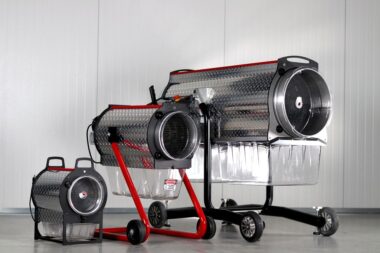
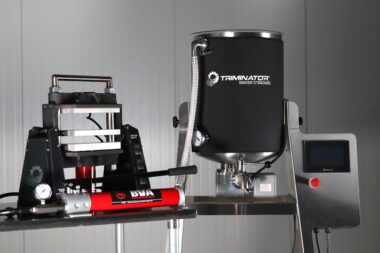
Frequently Asked Questions
Why Is Trichome Preservation So Important When Harvesting Cannabis?
Trichomes contain cannabinoids which contribute to the potency of harvested buds. Trichomes also contain other cannabis compounds like terpenes and flavonoids, both of which lend to the unique effects of various cannabis strains. By preserving trichomes on cannabis when harvesting, you substantially increase the potency and quality of your product.
How Do You Identify Trichomes On Cannabis?
Trichomes are the resinous crystal “hairs” that cover cannabis buds and leaves. They appear when growing cannabis plants begin to flower. Because each cannabis trichome is so small, they are best identified with a magnifier or jeweler’s loupe.
Is Hand Trimming Or Machine Trimming Better For Preserving Trichomes?
While skilled hand trimming can be beneficial for trichome retention, advances in machine trimming technology now offer increased trichome preservation. Not only do machine trimmers preserve trichomes on cannabis, but they also offer increased ease and efficiency for both small and large-scale operations interested in high-quality trimmed cannabis.
Is Wet Trimming Or Dry Trimming Better For Trichomes?
Most growers agree that wet trimming is superior to dry trimming for trichome retention, as trichomes are more susceptible to damage when they are dry and brittle. You can look for a machine trimmer that can perform both wet and dry trimming to accommodate the various cultivars you may be growing.
Like what you read?
Get more insider industry knowledge sent right to your inbox
"*" indicates required fields